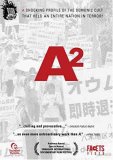| Reviews & Columns |
|
Reviews DVD TV on DVD Blu-ray 4K UHD International DVDs In Theaters Reviews by Studio Video Games Features Collector Series DVDs Easter Egg Database Interviews DVD Talk Radio Feature Articles Columns Anime Talk DVD Savant Horror DVDs The M.O.D. Squad Art House HD Talk Silent DVD
|
DVD Talk Forum |
|
|
| Resources |
|
DVD Price Search Customer Service #'s RCE Info Links |
|
Columns
|
|
|
A2
In the years since the first film, the remaining members of Aum Shinriku have seen their religion- okay, cult- fragmented and in disarray after years of public scrutiny and internal divisions. Leadership roles have shifted, opinions are split over the groups dogma, their numbers and facilities have dwindled, and what remains is met with almost nothing but contempt and fear from Japan's citizens.
Neighborhood watchdog groups have sprouted up where Aum members have taken up residence. The groups watch cult members every move and pepper the area with signs denouncing their beliefs, urging them to either quit the cult or just leave the area. More vocal, a group of nationalists engage in along confrontation with the police who have blockaded off an area where a controversial Aum leader resides. Its an amazing scene, the nationalists are nothing but belligerent, yet claim it is the police who are being unfair. They later stage a more level-headed march protest. By the end of the doc, you see the dismantling of one watch station in an area where the cultists and residents have actually grown oddly fond of one another.
And, as the first film showcased, there is the media, which approaches Aum from a purely sensationalist veiwpoint that only makes the members more unwilling to trust the outside world. For instance, cult members recount in the film how a disturbed woman who had just joined them, then tried to harm herself, was trashing the place, so they put her in a bathroom and tried to calm her down. Yet the media portrayed the incident from the distubed woman and the police's perspective, that they were holding the woman captive and brainwash her. Its a paradox- Aum doesnt want to talk to the media because of how they are portrayed, which probably makes it easier for the media to not do any fact checking with Aum.
Both of the docs, especially this one, make you realize the strange contrast one is presented with when it comes to Aum. Religious beliefs are not tactile. Followers make what they will and are guided by pure intangibles, like faith. While most fo the remaining members follow teachings that say they shouldn't even harm an ant, the core of their group and its creator did indeed perpetuate unspeakable acts.On one hand, the Japanese public has every right to demonize the group, but as religious followers, you understand Aum's blind devotion and desire to stick with the religion thatt they have dedicated themselves. So as a viewer you are left with some empathy for these poor, misguided followers still grasping at their beliefs, yet, they are also in every way, getting what they deserve and would be all the better if their religion was dismantled. But, of course, it is just not that simple.
The point of view of both films is very interesting. You do not get every side of the story. Though they are points that are touched on, you do not even get a very detailed look into what Aum members believe. If anything, the film becomes a tad repetitive when it gets into things like their basic dietary habits, meditation, and the like. Tatsuya Mori's decision to present an insiders view of how society treated Aum (the public anger, the media bias, the polic bracing) lead to the film being not only blacklisted from theaters and TV screening in Japan but also lead to rumors that Mori hired actors to portray sympathetic Aum members. It was certainly a brave choice to make as a film maker, and the duo of films give you laser focused insight into one aspect of this particular cult's trails and tribulations.
The DVD: Facets.
Picture: Full-screen, Standard. Again, like the first film, Mori worked on the cheap, totally indie, and used fairly basic video equipment. Based on the transfer, he may have gotten slighter better cameras from the first to second project because there is just a slight improvement in the image quality.
Sound: 2-channel Japanese language with optional English subtitles. Again, basic stuff. The audio gets the job done and the subtitles are excellent.
Extras: Trailers for A and A2. -- Liner Notes.
Conclusion: A neat and very unique pair of docs that come with a recommendation for anyone interested in the subject. I think both films are alittle on the long side, but part of the perspective is to show how mundane and simple the members lives are and the monotonous task of having an illogical theology that you must explain. While not the final word or complete view of its subject matter, it is still an amazing insight into a secretive and controversial group.
|
| Popular Reviews |
| Sponsored Links |
|
|
| Sponsored Links |
|
|
| Release List | Reviews | Shop | Newsletter | Forum | DVD Giveaways | Blu-Ray | Advertise |
|
Copyright 2024 DVDTalk.com All Rights Reserved. Legal Info, Privacy Policy, Terms of Use,
Manage Preferences,
Your Privacy Choices | |||||||












